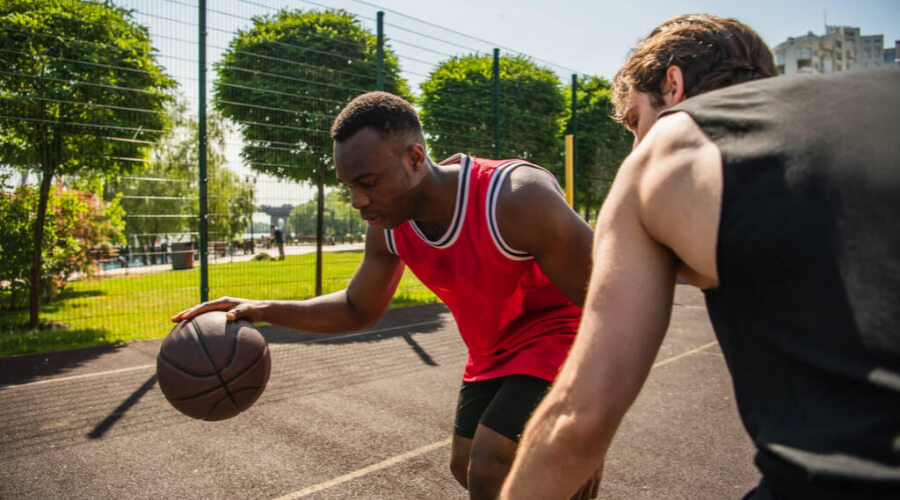Last Updated on October 21, 2023 by Alex PT
Indoor basketball is played in climate-controlled arenas with hardwood floors, while outdoor basketball is played on asphalt or concrete courts. Indoor games use a standard NBA ball size of 29.5 inches, whereas outdoor games often use a 28.5-inch ball.
The Difference Between Indoor And Outdoor Basketballs
| Characteristic | Indoor Basketball | Outdoor Basketball |
|---|---|---|
| Playing Surface | Indoor hardwood or synthetic courts. | Outdoor asphalt or concrete courts. |
| Material | Composite leather or synthetic materials, softer touch. | Rubber or durable materials, withstands rough surfaces. |
| Grip | Provides better grip, suitable for controlled gameplay. | Less grip, handles outdoor conditions and weather. |
| Bounce | Consistent and reliable bounce due to softer materials. | Slightly less consistent bounce due to harder cover. |
| Durability | Less durable, not suitable for rough outdoor surfaces. | Highly durable, resistant to wear and tear. |
| Size | Standard NBA size (29.5 inches in circumference). | Slightly smaller (28.5 inches in circumference). |
| Weight | Lighter weight for precise handling and shooting. | Heavier weight for stability in outdoor conditions. |
| Weather Resistance | Not designed for outdoor conditions, degrades in rain. | Resistant to outdoor weather, handles rain and sun. |
Indoor VS Outdoor Basketball – Differences

Performance
Indoor basketballs are designed and built to excel on indoor courts, delivering an exceptional playing experience. The only type of ball you’ll see on indoor courts during practice or games between the high school, professional, and collegiate teams are indoor balls. That’s because they perform much better than outdoor balls on indoor courts.
High-quality indoor balls don’t easily lose grip thanks to the 35,000 pebbles over the entire ball surface which is equivalent to 122 pebbles per square inch. With this type of pebble structure, indoor balls offer exceptional stickiness and a superior grip. Outdoor basketballs, on the other hand, are designed and built with fewer per square inch and larger pebbles, which decrease its grip and enhance a rougher feel.
Cover Material Used
The material used for the construction is one of the most significant differences between outdoor and indoor basketballs. In most cases, outdoor basketballs are either made of composite or rubber leather while full-grain leather materials are used for indoor basketballs.
Indoor basketballs are often smoother and feel softer to the touch than their counterparts. If you’ve ever played with the two types of basketballs, you’ll notice the soft feel of the indoor ball because it is made from full-grain leather. This high-quality composite material is responsible for the softer feel and great grip. Composite leather material incorporates both plastic and leather fragments.
It is quite durable, cheaper, and feels synonymous with the traditional leather material. There are hybrid basketballs that are made from composite leather. These hybrid balls are both suitable for indoor and outdoor games. They are robust and durable enough to handle the harshness and elements of outdoor games and still perform exceptionally on indoor courts.
On the other hand, outdoor basketballs are designed and built to be more durable with less grip and feel. Most of the time, it is difficult to find professional players playing with an outdoor ball. Outdoor balls are meant to be used by amateurs and recreational players. That’s why these balls are built to withstand elements outside.
You don’t wanna play an indoor ball on an outdoor basketball court, because it was made from less durable materials when compared to outdoor balls. Playing indoor basketball on asphalt or concrete surfaces will damage or soften the outer layer. That’s not all. Elements like dust and rain on outdoor basketball courts are too harsh for indoor balls and will cause them to deteriorate more quickly, resulting in peeling and reduced performance.
Flexibility
If you’re a professional player in the game of basketball, you should know that it isn’t right to play with an outdoor ball on an indoor court. Since they feel a little bit hard and bouncy, especially on wooden surfaces like indoor courts, you might fight it hard to control, grip, and shoot. This will definitely have negative impacts on your games.
Having said that, some experienced players still play with a slightly deflated outdoor ball on outstanding-performance indoor courts. However, indoor basketballs are less flexible and would not perform excellently on outdoor courts. Don’t forget that these balls are not even exceptionally durable and come with a fragile leather surface that will peel off when used on hard outdoor courts.
Durability
In terms of durability, the two types of basketballs are quite different. You can play with an outdoor ball on an indoor basketball court even though the overall performance in terms of ball control and shot quality might be under par.
It can withstand any indoor surface without any hassle. Meanwhile, the leather of indoor balls will peel or crack when played on outdoor courts with hard and rough surfaces. Nonetheless, indoor basketball should last you some years if you keep playing on indoor courts only.
Cost
The price range is another significant difference between these two ball types. Outdoor balls are less expensive and you’ll certainly get a good ball for just $25. You don’t necessarily have to break the bank to get a high-quality outdoor ball.
Good indoor balls, on the other hand, are quite expensive. Some high-quality indoor balls cost above $110. It all depends on the quality of the ball that you want and your budget, you can still get a low to medium-quality indoor ball at $30.
How to choose the right basketball for your needs?
Selecting the right basketball involves considering your needs, playing environment, and personal preferences. Here’s a detailed guide on how to choose the right basketball:
- Know Your Environment:
- Indoor vs. Outdoor: Determine where you’ll primarily play. Indoor balls are best for gym use, while outdoor balls are built for rough surfaces.
- Consider Ball Material:
- Indoor: These balls are made of composite leather or synthetic materials, offering a soft touch and good grip. Ideal for precise gameplay.
- Outdoor: They’re constructed from rubber or durable materials, providing resilience on harsh surfaces.
- Grip and Feel:
- Test the ball’s grip and feel. Indoor balls have better grip, while outdoor balls may have a slightly rougher texture to withstand outdoor conditions.
- Bounce Consistency:
- Indoor balls provide a consistent and reliable bounce. Outdoor balls may have a slightly less predictable bounce on hard surfaces.
- Durability:
- Assess the ball’s durability. Indoor balls are not suitable for outdoor play and can degrade quickly. Outdoor balls are built to withstand wear and tear.
- Size and Weight:
- Choose the right size. Standard NBA size is 29.5 inches in circumference, while smaller 28.5-inch balls are suitable for youth or women’s leagues.
- Consider the weight. Indoor balls are lighter for precise handling, while outdoor balls are heavier for stability in outdoor conditions.
- Weather Resistance:
- Outdoor balls are designed to withstand outdoor weather, such as rain and sun. Indoor balls are not weather-resistant and degrade in wet conditions.
- Brand and Model:
- Recognized brands like Spalding, Wilson, and Nike produce quality basketballs. Consider specific models and read reviews for performance insights.
- Personal Preference:
- Feel the ball in your hands. It should be comfortable and suit your playing style.
- Some players prefer a specific brand or model due to personal preference and familiarity.
- Budget:
- Set a budget. High-quality balls can be expensive, but they tend to last longer and perform better.
- Test the Ball:
- Whenever possible, test the ball by dribbling, shooting, and passing. This hands-on experience can help you make an informed decision.
- Check Regulations:
- If you’re buying a ball for league play, ensure it meets the specific regulations of the league or organization you’ll be participating in.
FAQs
We’ve prepared some frequently asked questions and answers for a better understanding of the differences between the two ball types.
Can You Play Indoor Basketball On Outdoor Courts?
Just like we said earlier, the materials used for the construction of indoor basketballs are not as durable and rigid as the ones used for outdoor balls. They will peel, wear, and tear quickly when used for outdoor games. Indoor balls are only suited for indoor basketball courts.
What Are The Disparities Between Outdoor And Indoor Games?
Indoor games help players developmental and intellectual abilities while outdoor games help with physicality. Most of the time, indoor games require only small spaces while outdoor games need big surfaces. Indoor basketball games are mostly played by professionals and serious players while outdoor games are enjoyed by amateurs and recreational players.
What Happens When You Leave A Basketball Outside?
The quality of your ball and its overall grip will be diminished when left outside in the rain or any other wetness. More so, the shape of the ball can be tampered with or warped by certain temperatures. Lastly, the color of the ball might fade away when exposed to direct sunlight for too long.
How Long Do Indoor/Outdoor Basketballs Last?
The longevity of a basketball depends on how you maintain it, the build quality, and the number of times you’ve played with it. A high-quality ball made from rubber will last about three to six months before losing its grip if you play it every day for one to three hours.
Final Thoughts
Choosing between the two basketball types depends on your game needs. You don’t have to buy an indoor ball if you’re not playing to play on indoor basketball courts as a professional. Indoor balls are mostly suited for professional players. As a recreational player, an outdoor ball is the best option. It will perform well on harsh and rough surfaces. However, if you’re planning to play on both surfaces, the outdoor ball might be the most preferable option.
References:
https://www.quora.com/What-s-the-main-difference-between-an-outdoor-basketball-vs-a-combination-indoor-outdoor-basketball
https://www.mastertheyard.com/difference-between-indoor-outdoor-basketball/

Hi! I’m Alex PT. I hold a Bachelor’s degree in Sports Management from Indiana University and have over seven years of valuable experience working in a Sports Event Management Company. I founded SportBlurb with the passion for bringing you the latest, most insightful, and engaging content in the world of sports. So, whether you’re a die-hard fan or want to stay informed, I’ve got you covered!

